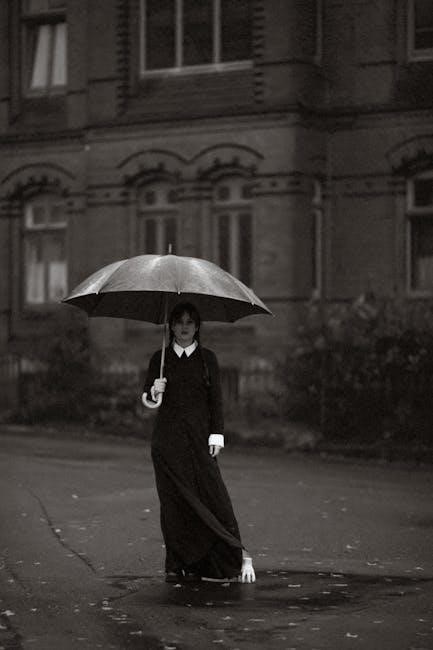Unmentionable offers a satirical yet insightful exploration of Victorian womanhood, blending humor with historical accuracy to reveal the unseen challenges of 19th-century women’s lives, from hygiene to marriage.
1.1 Overview of the Book

Unmentionable: The Victorian Lady’s Guide to Sex, Marriage, and Manners by Therese O’Neill is a witty, illustrated guide that uncovers the often-overlooked realities of Victorian womanhood. The book delves into the social expectations, hygiene practices, and marital norms of 19th-century women, offering a satirical yet deeply researched perspective. With humor, O’Neill explores topics like menstruation, fashion, and sexuality, revealing the challenges women faced in a society governed by strict etiquette. The book is both a historical account and a humorous critique, designed to entertain while educating readers about the complexities of Victorian life. By blending fact and satire, O’Neill creates a compelling narrative that challenges romanticized notions of the era, making it a unique and engaging read.
1.2 Purpose of the Guide
Unmentionable serves as both a humorous and enlightening guide, aiming to dispel romanticized notions of Victorian life. By blending satire with historical research, Therese O’Neill sheds light on the often-overlooked struggles of 19th-century women, from restrictive gender roles to dangerous beauty standards. The guide’s purpose is not only to entertain but also to educate, offering a candid look at the societal expectations and daily challenges women faced. Through its unique blend of humor and history, Unmentionable encourages readers to appreciate the progress made since the Victorian era while fostering empathy for women who navigated its rigid norms. Ultimately, the book acts as a reminder of how far women’s rights and freedoms have evolved, making it a valuable and engaging read for modern audiences.

Social Expectations of Victorian Women
Victorian women were bound by strict societal norms, emphasizing modesty, domesticity, and submissiveness. Their roles were largely confined to marriage and motherhood, with little freedom for personal ambition or independence.
2.1 Gender Roles and Societal Norms
Victorian women were confined to rigid gender roles, with societal norms demanding modesty, submissiveness, and domesticity. They were expected to prioritize marriage and motherhood above all else, with little autonomy outside these roles. The idea of a “true lady” emphasized purity, silence, and obedience, while discouraging ambition or independence. Women were often seen as fragile and in need of male protection, reinforcing their subordinate status. These norms were deeply ingrained, leaving women with limited opportunities for self-expression or personal growth. Unmentionable critiques these expectations, using satire to highlight the absurdity and oppression inherent in such restrictive societal norms. By exposing the hypocrisy and double standards, the guide offers a humorous yet poignant commentary on the era’s gender dynamics.
2.2 Class Distinctions and Their Impact
Class distinctions played a pivotal role in shaping the lives of Victorian women, with societal expectations varying dramatically across different strata. Middle-class women were often burdened by the pressures of maintaining a respectable household, while working-class women faced the harsh realities of labor and limited access to resources. The guide highlights how class influenced access to education, marriage opportunities, and even personal hygiene. Wealthier women could afford luxurious clothing and beauty products, whereas poorer women struggled with basic necessities. Unmentionable satirically exposes the hypocrisy of class-based double standards, where upper-class women were praised for their refinement, while working-class women were often judged harshly for their practicality. These class distinctions not only dictated women’s roles but also perpetuated inequalities, making it difficult for women to transcend their societal positions. The book humorously critiques the absurdities of these class-driven norms, offering a stark reminder of their enduring impact.
Hygiene and Beauty Standards
Victorian hygiene was often primitive, with face creams containing arsenic and clothing rarely washed. Beauty ideals demanded pale skin and corseted figures, promoting harmful practices to meet societal expectations.
3.1 Personal Cleanliness Practices
Victorian women faced significant challenges in maintaining personal hygiene. They often used face creams containing arsenic to achieve a pale complexion, despite its toxicity. Clothing was rarely washed due to the labor-intensive process, leading to persistent body odor. To manage this, women relied heavily on perfumes and powders. Additionally, chamber pots were commonly kept under beds for convenience, emphasizing the lack of modern sanitation. Menstruation was a taboo topic, and women used rags or homemade cloths, which were often unhygienic. The guide highlights how societal expectations prioritized appearance over health, leading to dangerous practices that compromised women’s well-being. These practices underscore the harsh realities of daily life for Victorian women, revealing a gap between aesthetic ideals and practical hygiene.

3.2 Beauty Products and Their Dangers
Victorian women often risked their health for beauty, using products laden with toxic ingredients. Face creams frequently contained arsenic, which was prized for its ability to create a fashionable pale complexion but could lead to severe poisoning. Belladonna, a poisonous plant, was applied as eye drops to dilate pupils, creating a desirable “wide-eyed” look. Lead-based cosmetics were common, causing skin discoloration and long-term organ damage. These practices highlight the dangerous lengths women went to meet societal beauty standards. The guide reveals how these products, while intended to enhance beauty, often had life-threatening consequences. Such practices underscore the sacrifices women made to conform to Victorian ideals of femininity and appearance.

Fashion in the Victorian Era
Victorian fashion was complex and restrictive, with multiple layers of undergarments, tight corsets, and heavy fabrics. These impractical styles often compromised women’s health for societal expectations of elegance.
4.1 Clothing Layers and Undergarments
Victorian women wore multiple layers of undergarments, including chemises, drawers, corsets, and petticoats, designed to shape the body and maintain modesty. The corset, tightly laced, was central to achieving the desired slim silhouette, often at the cost of comfort and breathability. These layers were cumbersome and restrictive, reflecting societal expectations of femininity and propriety. The guide humorously highlights the impracticality of such attire, emphasizing how women navigated daily life amidst such restrictive clothing. The undergarments also symbolized social status, with finer fabrics and intricate stitching reserved for wealthier women. This intricate system of clothing layers underscored the oppressive nature of Victorian fashion, prioritizing appearance over comfort and practicality.
4.2 Fashion’s Impact on Women’s Health
Victorian fashion, with its tight corsets, heavy fabrics, and multiple layers, severely impacted women’s health. The corset, laced tightly to achieve a slim figure, restricted breathing and displaced internal organs, leading to fainting and digestive issues. Women often suffered from respiratory problems due to prolonged constriction. Heavy skirts and layers caused overheating, while poor ventilation in clothing led to skin infections and odors. The use of arsenic in green dyes posed toxic risks. High heels and heavy footwear strained muscles, and the weight of elaborate hairstyles added neck and back pain. These fashion practices, driven by societal ideals, prioritized aesthetics over well-being, contributing to long-term health issues and discomfort for women. The guide highlights these sacrifices, revealing the harsh reality behind the era’s beauty standards.
Marriage and Sexuality
Marriage and sexuality in the Victorian era were shaped by rigid societal norms, with women often lacking agency in their romantic and sexual lives, expected to fulfill roles defined by convention rather than personal desire.
5.1 The Institution of Marriage
In the Victorian era, marriage was a cornerstone of society, often arranged based on social class and economic convenience rather than love. Women had little agency in selecting their husbands, with their roles typically confined to managing households and bearing children. The concept of “marital duty” was paramount, requiring women to submit to their husbands’ sexual demands without question. Divorce was rare and socially stigmatized, particularly for women, as it could lead to societal ostracism and financial ruin. This rigid structure underscored the power imbalance, with men holding authority over their wives’ lives and decisions.
- Marriages were frequently arranged for economic or social status reasons.
- Women were expected to manage households and prioritize childbearing.
- Sexual submission was deemed a marital duty, with little regard for women’s consent or pleasure.
- Divorce was socially unacceptable and often unattainable for women.
5.2 Sexual Expectations and the Wedding Night
The wedding night in Victorian times was often a woman’s first sexual experience, shaped by societal pressures and rigid expectations. Women were expected to remain chaste until marriage, while men were frequently excused for prior sexual encounters. The concept of “marital duty” dictated that women must endure their husbands’ advances without complaint, reflecting the era’s power dynamics. Many women were unprepared for the realities of sex, as open discussion about it was taboo. The guide highlights the stark contrast between romantic ideals and the often brutal realities of Victorian weddings, where women’s bodies were seen as vessels for their husbands’ desires rather than their own autonomy.
- Wedding nights marked women’s introduction to sex, often without prior knowledge or consent.
- Men were expected to assert dominance, while women were to submit silently.
- The idea of “marital duty” prioritized men’s pleasure over women’s comfort or desire.

Menstruation and Women’s Health
Unmentionable reveals the stigma and challenges surrounding menstruation in the Victorian era, where women faced inadequate hygiene, societal shame, and significant health risks due to limited understanding.
6.1 Societal Attitudes Toward Menstruation
Victorian society viewed menstruation with profound stigma and shame, often treating it as a taboo topic. Women were expected to conceal their cycles, and open discussion was discouraged. The lack of proper hygiene products forced women to rely on makeshift solutions, such as rags or homemade cloths, which were often unhygienic. Menstruation was seen as a sign of weakness and something to be hidden, reflecting broader societal attitudes that demeaned women’s bodily functions. This shame was reinforced by limited education and the belief that women should be delicate and unbothered by such “unladylike” matters. The secrecy surrounding menstruation further isolated women, making it a source of silent suffering. O’Neill’s guide humorously exposes these absurdities, highlighting how societal norms perpetuated misinformation and discomfort for Victorian women.
6.2 Managing Menstruation in the Victorian Era
Managing menstruation in the Victorian era was a clandestine and unsanitary ordeal. Women relied on homemade cloths, rags, or even shared pads, which were often washed and reused. These makeshift solutions were far from hygienic, leading to frequent infections and discomfort. The lack of proper hygiene products forced women to improvise, using materials like cotton, linen, or even newspaper; Social norms demanded discretion, making it difficult for women to address their needs openly. The restrictive clothing of the time, with multiple layers of undergarments, further complicated matters. O’Neill’s guide vividly portrays these challenges, revealing how women endured such conditions with limited resources and societal pressure to maintain silence. The era’s approach to menstruation was both impractical and unhealthy, reflecting the broader neglect of women’s health.

Satire and Humor in the Guide
Therese O’Neill’s guide masterfully blends satire with historical insight, using humor to expose the absurdities of Victorian societal norms. Her witty commentary highlights the era’s hypocrisies, making the content both entertaining and enlightening.
7.1 Therese O’Neill’s Use of Humor
Therese O’Neill’s humor in Unmentionable is sharp and irreverent, offering a modern perspective on the absurdities of Victorian life. She uses wit to highlight the era’s contradictions, such as the obsession with purity alongside dangerous beauty practices. O’Neill’s comedic tone makes the book relatable and engaging, while her historical accuracy ensures it remains informative. By mocking the societal hypocrisy, she sheds light on the challenges women faced, like restrictive clothing and inadequate hygiene. Her ability to balance humor with insight makes the guide both entertaining and enlightening, providing readers with a fresh understanding of Victorian womanhood. The humor never feels crass; instead, it serves as a tool to critique and educate, making the book a unique blend of history and satire.
7.2 The Role of Satire in Highlighting Societal Issues

Satire in Unmentionable serves as a powerful tool to expose the hypocrisy and absurdity of Victorian societal norms. By ridiculing the era’s rigid expectations, O’Neill sheds light on the oppressive realities faced by women, such as restrictive clothing, toxic beauty standards, and the denial of female sexuality. The book’s satirical tone allows readers to critically engage with these issues while maintaining a sense of humor. O’Neill’s approach highlights the contradictions between the Victorian ideal of femininity and the harsh, often dangerous conditions women endured. This blend of humor and critique makes the book both entertaining and thought-provoking, offering a fresh perspective on a historically rigid society. The satire not only educates but also encourages readers to reflect on how modern perceptions of the Victorian era often overlook its darker truths.
Victorian Realities vs. Modern Perceptions
Modern perceptions often romanticize the Victorian era, overlooking its harsh realities. The book reveals the stark contrast between idealized notions and the gritty truths of women’s lives, challenging popular myths.
8.1 Common Misconceptions About the Era
Many modern perceptions of the Victorian era are rooted in romance and nostalgia, often overlooking its harsh realities. The book challenges these illusions, revealing the grim truths about women’s lives. One major misconception is the notion of Victorian women as pristine and hygienic, when in reality, personal cleanliness was limited, and practices like sharing undergarments were common. Another myth is the romanticization of marriage, which was often a practical arrangement rather than a love match. The era’s rigid social norms and the suppression of women’s bodily functions, such as menstruation, are also frequently downplayed. Unmentionable uses satire to expose these misconceptions, offering a candid look at the era’s hypocrisy and the struggles women faced. By doing so, it encourages readers to rethink their idealized views of the past.
8.2 Lessons for Modern Readers
Unmentionable offers valuable lessons for modern readers by highlighting the stark contrast between Victorian realities and contemporary values. It encourages gratitude for the progress made in women’s rights, hygiene, and social equality. The book also prompts readers to question and challenge outdated societal norms that still linger today. By exposing the hypocrisy and constraints of the Victorian era, it fosters empathy for women who endured such hardships. Additionally, it underscores the importance of open dialogue about topics once considered taboo, such as sexuality and menstruation. Through its blend of humor and history, Unmentionable reminds us to appreciate the freedoms we enjoy now while advocating for continued progress in gender equality and personal autonomy.
